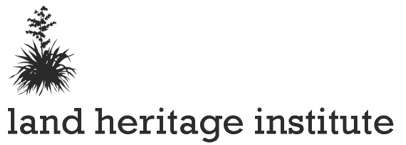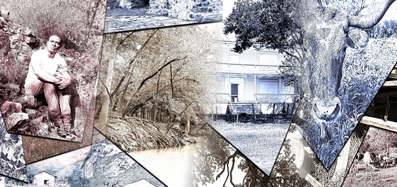LHI Art-Sci Projects









LHI Art-Sci Projects Director:
Dr. Penelope Boyer
LHI ART-SCI SYMPOSIA:
2013: Why Art-Sci? Analyzing a Paradigm
2009: The Nature of Place: Land Art/Land Use
A review of the 2009 LHI Art-Sci Symposium in ART LIES, a
LHI/FOTOSEPTIEMBRE USA Artist-in-Residence Projects:
2010: Nancy Cavender-Garcia, et al - Diverse Cultures / One Land
2009: Ansen Seale - The Corn Crib
LHI Art-Sci Projects in the news:
2/20/2012: WOAI TV airs a piece about Kickstarter featuring the Corn Crib.
*
LHI: The biggest art lab in town (all 1,200 acres of it)
By Scott Andrews, SAN ANTONIO CURRENT
PUBLISHED: AUGUST 31, 2011 “The words aren’t there yet, this is hard to talk about,” said Penelope Boyer, director of the Land Heritage Institute. We’re talking about a new art practice that happens in wild areas, away from cities. Rooted in the land art movement that began with projects like Robert Smithson’s Spiral Jetty, constructed in 1970 on the shore of the Great Salt Lake, and continuing with James Turrell’s Roden Crater project in northern Arizona, land art has created massive earthworks in the wilderness. The new art is exploratory, rather than monumental; a tool to learn how to coexist in a changing ecosystem. This is a good weekend to learn more. On Friday the Land Heritage Institute will host an open bar fundraiser with music by Buttercup, and Land as Lab, this year’s LHI Art-Sci Symposium, will take place Saturday on the 1,200-acre LHI preserve south of SA on the Medina River. Land as Lab brings visual and performing artists, scientists, and activists engaged in interdisciplinary experiments to discuss what will become the topic of the century: water scarcity and the desertification of the world. Let’s just say that here South Texas is for once ahead of global trends. Hadley and Peter Arnold of the Arid Lands Institute will give a road map to possible futures, sure to be dystopian if we don’t pay attention soon. Also presenting is Nancy Zastudil of Tres Piedras, N.M., whose project PLAND, Practice Liberating Art through Necessary Dislocation, is an off-the-grid residency program that supports the development of experimental and research-based projects in the Taos mesa. Also presenting are Jennifer Monson of iLAND, the Interdisciplinary Laboratory for Art, Nature and Dance, Kirsten and Peter Stoltz, scientists whose M12 project creates site-specific art works, and too many others to mention here. Local artists Chris Sauter, Buster Graybill, Ariel Evans, and arts writer Anjali Gupta (past-editor of Art Lies) will run commentary throughout what will no doubt go down as the hottest environmental art conference for ages. And it’s happening here, go figure.
What’s LHI? One day in the early 1980s, an engineering inspector named Richard Beene discovered signs of ancient habitation while doing routine archeological salvage work ahead of the proposed Applewhite Reservoir, just south of SA. Lab testing of the day’s finds, and evidence from Texas A&M archaeologists’ study of over a dozen other sites, later attested to over 10,000 years of human habitation in the area. Members of the American Indians in Texas, descendents of the Coahuiltecans and Tonkawa, had believed that for ages, but forensic science clinched it. Fast forward to today — the Land Heritage Institute maintains 1,200 acres of open space on the Medina River as a living land museum, protecting the local ecosystem and archaeological sites, while providing access for hands-on history lessons, hiking, bird watching, and trail riding.
LHI Benefit: $25, 8:30-10:30pm Fri, Sep 2, open bar + food, music by Buttercup. On the banks of the San Antonio River behind the SA River Authority, 100 E Guenther.
Land as Lab LHI Art-Sci Symposium: Free, 9am-6:30pm Sat, Sept 3, LHI at 1349 Neal, (210) 829-1737, landheritageinstitute.org. Vegetarian chuckwagon lunch $6.
a living land museum on 1200 acres of open space along the banks of the Medina River on the far south side of San Antonio preserving, maintaining and interpreting 10,000 years of continual human habitation
LHI Art-Sci Symposia Speakers
(2009 - )
Hadley & Peter Arnold, Founder/Directors, Arid Lands Institute (Woodbury University, Burbank, CA)
Dr. Elizabeth de la Portilla, Anthropologist, San Antonio College (SATX)
Ariel Evans, Founder/Editor, Pastelogram (Austin, TX)
Buster Graybill, Artist (SATX)
Aline James, Environmental Science Engineer, University of Texas (El Paso, TX)
Joan Jonas, Artist, M.I.T. (Cambridge, MA)
Amy Kastely, Attorney, Free Speech Coalition (SATX)
Erik Knutzen, Program Manager, Center for Land Use Interpretation (Culver City, CA)
Carol Lafayette, Artist, Associate Professor of Visualization, Texas A&M University (College Station, TX)
Lucy Lippard, Writer/Activist/Curator (Galisteo, NM)
Richard Lowenberg, Artist, Director, 1st Mile and Science-Artist Research Collaborations (Santa Fe, NM)
Dr. Kelly Lyons, Restoration Ecologist/Invasive Species Specialist (SATX)
Don Jacinto Madrigal, Curandero (SATX)
Dr. Roger Malina, Physicist, Astronomer, Editor-in-Chief of Leonardo magazine, Distinguished Professor/Associate Director of Arts and Technology, University of Texas (Dallas, TX)
Jennifer Monson, Choreographer/Dancer/Founder, iLAND (New York, NY)
Celia Alvarex Muñoz, Artist (Arlington, TX)
Andrea Polli, Artist (Albuquerque, NM)
Lucinda Presley, Executive Director, ICEE - Institute where Creativity Empowers Education (Palestine, TX)
Leslie Raymond, Artist, Potter-Belmar Labs (SATX)
Dr. Ann Reynolds, Associate Professor, Department of Art & Art History, University of Texas (Austin, TX)
Francesca Samsel, Artist (Austin, TX)
Chris Sauter, Artist (SATX)
Beverly Singer, Filmmaker, Associate Professor of Anthropology and Native American Studies, University Regents Lecturer, Director of the Institute for American Indian Research (Albuquerque, NM)
Kirsten Stoltz, Program Director, M12 (Yuma, CO)
Alluquere Rosanne Stone, Artist, Founder/Director, ACT-LAB, University of Texas (Austin, TX)
Chris Taylor, Director, Land Arts of the American West, Texas Tech University (Lubbock, TX)
Dr. Alston Thoms, Archeologist, Texas A&M University (College Station, TX)
Ramon Vasquez, Executive Director, American Indians in Texas at the Spanish Colonial Missions (SATX)
Liz Ward, Artist (SATX)
Ruth West, Artist-researcher, Associate Professor cross-appointed in College of Visual Arts and Design/New Media, College of Information/Library & Information Sciences, College of Arts and Sciences/Biological Sciences and the iARTA research cluster; xREZ Lab Director (Denton, TX)
Nancy Zastudil, Co-Founder, PLAND (Tres Piedras, NM)
LHI
mailing address:
114 e. cevallos
san antonio, tx 78204
physical address:
1349 neal rd.
bet. applewhite & pleasanton roads
san antonio, tx 78264
ph. 210.846.9403
fax 210.829.1730

